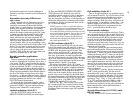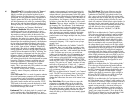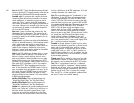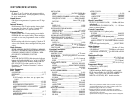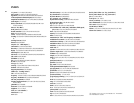Fingered Porta This is an abbreviation for "fingered
portamento." This is a functional mode of the DX7
which is available only when the keyboard is set to
MONO operation. Provided the unit is set to fingered
portamento, and the portamento time is greater than 0
(actually greater than 30 for any significant effect), you
will hear portamento only when you continue holding
down one key and then press and release another key
Pressing one key at a time will produce no portamento.
FM An abbreviation; see "Frequency Modulation."
Frequency Modulation When the output level of one
waveform is made to vary in frequency by a circuit
which combines it with a second waveform, the result-
ing complex waveform is said to be the result of fre-
quency modulation. This is not the simple mixing of two
frequencies, but rather it is a process which results in
the creation of sum and difference frequencies (the fun-
damental plus the modulating frequency, the fundamen-
tal plus twice the modulation frequency and so forth,
and the fundamental minus the modulating frequency
and so forth). Some of these "sidebands" theoretically
extend below 0 Hz, which is actually impossible in an
analog synthesizer. However, the FM digital synthesizer
correctly follows the equation for FM by "reflecting" the
negative frequency components back into the positive
frequency domain, but with their phase shifted 180
degrees. In some cases, these "reflected" components
will subtract from the level of the fundamental or certain
harmonics. Therfore, frequency modulation not only
creates side frequencies, it also changes the balance
between the fundamental, harmonics and subhar-
monics. This is one reason why FM synthesis can create
such interesting harmonic structures.
In the DX7, all the various, complex waveforms are
created by means of frequency modulation with sine
waves.
FUNCTION mode This is a mode of operation wherein
the overall performance parameters of the instrument
are programmed, such as polyphonic or monophonic
operation, or modulation from the modulation wheel,
after touch, breath conroller and foot controller. FUNC-
TION mode is also used to tune the keyboard, to check
the backup battery condition, to save or load voices
from a RAM cartridge, and so forth.
Fundamental This is the basic pitch of a musical note.
A note consisting only of the fundamental is a "pure"
tone, a sine wave. Most instruments play notes that also
contain varying amounts of overtones (harmonics) in
addition to the fundamental; the overtones create the
unique timbre of a given instrument. In the DX synthe-
sizers, the carrier often defines the fundamental pitch of
a voice, but not always; sometimes, due to the effects of
the modulators, the frequency of the fundamental may
be higher or lower than the set frequency of the carrier.
Harmonics These are integer multiples of a fundamen-
tal frequency The "first harmonic" is the fundamental.
The second harmonic is twice the fundamental, and so
forth. Harmonics are similar to overtones, except the
first overtone is the second harmonic. In the DX synthe-
sizers, harmonics are generally created by the interac-
tion of the modulator(s) with the carrier(s), although
parallel carriers set at integer multiples can also produce
harmonics.
Hz This is an abbreviation for "Hertz," the unit of mea-
surement for frequency 1 Hz is equal to one cycle per
second (1 cps).
INIT This is an abbreviation for "initialize." In the DX
synthesizers, there is no such thing as erasing a voice
memory. The memory including the editing buffer, will
always contain some data... some numbers that describe
a voice. If all data were set to zero, you would hear
nothing, and it would take a lot of programming to get
any sound at all. Therefore, when you INITialize the
buffer memory or the entire RAM cartridge (which you
can do with the [CART FORM] button in FUNCTION
mode), the DX7 stores a very simple, basic voice in the
memory This voice has all "square" envelopes (all rates
and levels at 99 except level 4, which is 0 — operator 1
output level at 99 and all others at 0 — all frequency
ratios at 1.00 — all modulation and other parameters set
to 0 or minimum value).
INT This is an abbreviation for "internal," as in "internal
voice". The DX7 has two primary places to store voices,
in the cartridges or in its internal memory The LCD
display often abbreviates the source of an internal voice
as
"INT."
Key Pitch Follow This is one of the two ways the
portamento or glissando effect can be set when the
synthesizer is in the POLY (polyphonic) mode. If you
play a note or chord and hold down the sustain pedal,
then release that note or chord and play any other note
or chord, the sustaining pitch(es) from the first note/
chord will slide up or down to the most recently played
note/chord.
Key Pitch Retain This is one of the two ways the
portamento or glissando effect can be set when the
synthesizer is in the POLY (polyphonic) mode. If you
play a note or chord and hold down the sustain pedal,
then release that note or chord and play any other note
or chord, the sustaining pitch(es) from the first note/
chord will continue to sustain at their original pitches. At
the same time, the most recently played note or chord
will begin at the pitch of the sustaining note/chord, and
will then slide up or down to the proper pitch(es).
kHz An abbreviation for "kiloHertz," or 1,000 Hz.
LCD This is an abbreviation for "liquid crystal display."
This is the type of display technology used to indicate
the name of selected edit parameters, functions and
voices on the DX7. Liquid crystal displays operate by
means of special chemicals which change their light
polarization characteristics when voltage is applied to
them. In combination with a constant polarized layer,
the voltage-altered crystal cancels out the light comple-
tely forming the black dots which create the alphabetical
and numerical symbols in the display. You can test this
effect by looking at the LCD with polaroid sunglasses —
at a certain angle, the display will be completely black.
LCD displays do have a limited viewing angle due to the
effect of light polarization, and at very high or very low
temperatures they may not function correctly However,
they are reliable, quite visible in bright light, and they
use very little power (making them popular for wrist-
watches and calculators).
LED This is an abbreivaition for "light emitting diode."
This
is
the
type
of
display technology
used
to indicate
the number of the selected internal or cartridge voice on
the DX7. Numerical light emitting diode displays actu-
ally consist of 7 segments for each number. Voltage
applied to the diodes is converted to light, red light in
this case. The DX7 LEDs are very visible in low light
levels and can be viewed over a wide angle.
LFO This is an abbreviation for "low frequency oscilla-
tor." Like the sine wave "oscillators" in the operators, the
LFO in the DX7 is actually a digital oscillator. However, it
can be set to create a square wave, a triangle wave, an
upward moving sawtooth, a downward moving saw-
tooth, or a sample-and-hold wave (random output) as
well as a sine wave. The LFO output can be varied in
"speed" over a range from under 1 Hz to about 50 Hz.
The LFO can be assigned to vary the amplitude of indi-
vidual operators, or the pitch of the entire voice.
60




